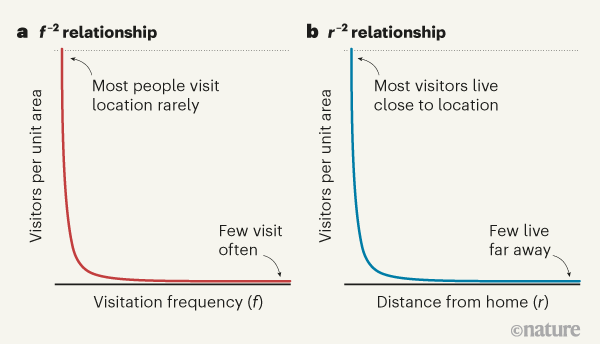As a scientist, you from time to time come throughout a obtaining that is distinct and robust, revealing a sample that was ideal in entrance of you all along — and which tends to make you want to kick oneself for not noticing it ahead of. The universal visitation regulation of human mobility, reported in Character by Schläpfer et al.1, is just this sort of a discovering. The authors uncover a pattern of human behaviour that connects travel length to the frequency of visits.
Contemplate any two sites. Can we forecast how numerous people today journey from 1 to the other, and vice versa, on the basis of the placement and very simple traits of the two destinations? This query is at the main of a massive entire body of literature whose origin dates back again to the mid-nineteenth century. In 1885, the geographer Ernst Ravenstein confirmed empirically that two essential things reveal the amount of people who transfer in between any two destinations2: the distance amongst the places, and the socio-financial attributes of the origin and place. The selection of travellers tends to reduce with length, for example, and additional-populated areas attract a lot more travellers.
These key observations had been later built-in into the gravity law of human mobility, which states that the amount of travellers amongst two metropolitan areas boosts with a ability of the cities’ populace sizes, and decreases with a power of the length amongst them3. A refinement of the gravity legislation, known as the radiation product, proposes that the number of travellers does not count directly on the length involving two towns, but fairly on the selection of areas among the cities at which people today would realistically end4.
Investigation into human mobility has flourished in the earlier few decades, as a final result of facts turning into offered with significantly wonderful spatial and temporal resolution5. This has allowed researchers to regulate the radiation and gravity models, and a myriad of variations, to capture vacation designs on a vary of timescales, like household relocation (residential mobility), airline journey, urban transportation and commuting. Schläpfer and colleagues now report a fundamental discovery in this highly energetic place of investigate. They have discovered a vital part that was lacking from existing theoretical frameworks of human mobility: visitation frequency (f), the selection of journeys that a person tends to make to a site for each unit of time.
The authors made their discovery by reframing the challenge confronted by modellers. As a substitute of focusing exclusively on length and sociodemographic features, they requested a even more query: ‘How numerous people dwelling in any specified place travel to any other put particularly n situations in a interval T?’ This transform in viewpoint is achievable mainly because mobility details for people are now accessible from cellular-cellphone monitoring. By finding out mobility traces extracted from phones at 7 urban spots all around the entire world, the authors uncovered a phenomenological legislation that answers their query: the number decreases with r2 (exactly where r is the length from someone’s property to a specified place), and with f2, wherever f = n/T (Fig. 1).
Remarkably, this law is valid for all the commonly different city techniques considered in the study, and consequently provides a standard framework for describing and predicting mobility flows across timescales. Importantly, the design accommodates varied mobility behaviours, from commuting to household mobility, devoid of demanding a transform of parameters.
To have an understanding of how the noticed sample emerges robustly from the multitude of unique behaviours, Schläpfer et al. designed a model of the mobility of people today that incorporates reasonable and well-comprehended mechanisms, these as people’s inclination to discover locations that are common with other visitors, and preferential return — an empirical phenomenon in which the selection of visits gained by a location is proportional to the selection of visits earlier received6. This design reproduces the collective styles of mobility noticed in the cell phone information. By linking the mobility of people today to collective results, the authors’ get the job done assists to narrow the hole amongst two streams of literature that have beforehand been broadly distinctive5. The results as a result pave the way for scientific tests that could deepen our theoretical understanding of how particular person and collective mobility patterns are related.
Just one unanswered question is irrespective of whether the designs of mobility observed in city places also use exterior cities. The geographies of rural places are much less centralized and incorporate much less spots of curiosity to visitors than do city areas these attributes may possibly consequence in vacation patterns various from those observed by Schläpfer and colleagues. One more key concern is no matter whether mobility patterns are diverse for excursions that are not anchored to people’s houses.
In their modelling of vacation patterns, the authors believe that persons head straight home after viewing any location. But in the serious entire world, geographical criteria and the need to lower journey time are likely to consequence in outings in unique reccurring sequences. Men and women generally go to areas in a sure buy, for example heading from do the job to the grocery store and gymnasium, and then household. We as a result foresee that models that capture the purchasing of visits will be important to providing a actually extensive description of collective mobility flows throughout house and time, and even far more exact predictions of actual-environment conduct. In the meantime, we hope the mobility designs uncovered by Schläpfer et al. to be practical for a variety of needs, from epidemic modelling to transportation preparing and urban style.
Competing Passions
The authors declare no competing passions.






More Stories
The Comprehensive Guide to Travel Insurance: Ensuring Peace of Mind for Your Adventures
Green Travel – Making Better Environmental Travel Choices
Cheap Flights to New York